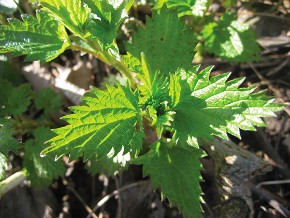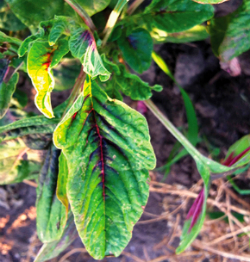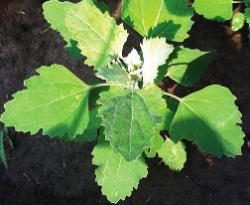When is a weed a weed? Midsummer abundance

We’re liberating the strawberries,” my sister reported, using the verb our mother chose long ago and that the whole family now uses instead of the more pedestrian term: weeding.
Every farming year has its unique music, composed by temperature, rainfall, and the interactions of a huge orchestra of natural, human, and mechanical parts. This year the dominant motif on my sister’s organic fruit farm and my brother’s organic vegetable farm has been the brassy, boisterous, fast and furious allegro con brio of weeds.
Liberation, never easy, becomes a Sisyphean task for a number of reasons. First, around the summer solstice every green thing’s chloroplasts go into overdrive, working for 18 hours straight, from the first rays of dawn until the solar power gives out at dusk. Because everything is growing at peak speed, if we are not planting or harvesting, then we need to be weeding. Second, this summer we’ve had weeks of frequent gentle rains followed by sunny skies—perfect conditions for accelerated growth of plant life. And finally, my brother Henry is once again farming the fertile bottom field after letting it lie fallow for four years—twice as long as usual.
Read our latest issue or browse back issues.
The long rest has been good for the soil structure, tilth, and fertility. But in those four years the weed seeds were laying low, waiting for their moment. Weeds specialize in colonizing disturbed sites and can maintain their abundance under conditions of repeated disturbance. This is a good thing on flood plains or steep hillsides, where weeds prevent erosion and help other plants get a foothold. Plowing produces the same cues as natural disturbances, so as Henry’s plow tilled under the alfalfa-clover hay mix that had been covering the fallow field, it prompted four years’ worth of weed seeds to germinate.
Conventional farms would respond to the flush of weeds by calling the nearest “crop protection” company to come douse the earth with poisons. But organic fruit and vegetable farmers do not outsource weeding to chemical companies and cannot put it off until a less busy day. Instead of chemicals we use human labor, and timeliness is crucial because weeds grow many times faster than vegetables. This means they will quickly outcompete, overtake, and snuff out vegetable seedlings, particularly the delicate and slow-growing ones. So we call all hands on deck or, more precisely, into the field to free the wispy dill, cilantro, beet, carrot, onion, parsley, and parsnip seedlings from the surrounding weeds that are already four times their size.
The tools of liberation are many and varied: Eliot Coleman’s colinear hoe (we call them “slicer hoes”), stirrup hoes (we call them “scuffle hoes”), regular hoes (the old-fashioned kind—we use them for hilling, or pushing the soil up against the crop to smother the weeds), Japanese hand hoes (ordered from Japan), rakes (sometimes used for hilling), push hoes (a wide scuffle hoe mounted on a frame with a wheel), and our fingers and hands (often the best tools of all).
Henry is as skilled with a hoe as a surgeon is with a scalpel, but I find that I do much better with hand weeding. This used to be a fairly easy task in any number of positions: bending over straddling the row, on one knee alongside the row, or on all fours over the row. These days none of these positions are good for very long, so I switch back and forth between them and envy younger folks to whom bending, straddling, and kneeling are as natural and easy as breathing.
One of the young ones, Henry’s son Kazami, reported the other day that “the weeds are pretty ridiculous. Before we push-hoed, some beds looked like a carpet of weeds. And even after you push-hoe, you still can’t see the seedlings you’re trying to save within the row.”
The main weeds threatening those seedlings at the moment are foxtail and amaranth. Yes, that amaranth. Which brings up the question, “What is a weed?” A standard definition is that it’s a plant in the “wrong place.” A soybean plant in a soybean field is a crop, but a soybean plant in a cornfield is a weed. My brother takes the definition one step further, to the temporal plane. Like a juvenile delinquent, a weed is a plant that’s in the wrong place at the wrong time.
If a plant is growing so close to your crop that it’s seriously depriving it of moisture or sunlight, then it’s a weed. Or if it’s about to go to seed, putting thousands more potential weeds in your field, then it’s a weed. But in most other situations, the so-called weeds are actually doing a lot of good. Weeds often have two or three time the amount of nitrogen, phosphorus, potassium, calcium, and magnesium as domesticated plants. This means they make good fertilizer when they break down. (The N, P, and K on fertilizer labels refer to nitrogen, phosphorus, and potassium, respectively.) But in addition to providing nutrients and organic matter, “weeds” offer a host of benefits: they hold the soil, preventing soil and wind erosion; they shade the earth and keep it cool, preventing moisture loss and preventing the soil biota from baking and the ground turning into something akin to concrete; they make your garden look more like nature and thus reduce insect, rabbit, and other critter damage by “hiding” the crops and offering “pests” an alternate source of food.
If, for example, you have low-growing chickweed or purslane in your garden, they are probably doing a lot more good than harm. They also happen to be delicious and highly nutritious, which places them firmly in the “good weed” category.
As native people around the world knew, and scientists are rediscovering, there are many edible weeds, including amaranth, nettles, dandelion, garlic mustard, purslane, chickweed, and lamb’s quarters. In fact, as Jo Robinson writes in Eating on the Wild Side, every vegetable was once a weed, and every vegetable has lost nutritional value in the process of being domesticated to human tastes: “The more palatable our fruits and vegetables became . . . the less advantageous they were for our health.”
 |
| Amaranth |
Amaranth, known as pigweed to most Midwestern farmers, is found all over the world and valued as a nutritious and delicious food from Asia to North and South America. Both the young tender greens, and the tiny grain the plants produce, have been a mainstay of widely varying cuisines. In China the greens are used as a stir-fry vegetable called yin choy. In the Caribbean, amaranth greens are known as callaloo and used in soups and sautés. Amaranth grain was one of the staple foodstuffs of the Incas and was also used by the Aztecs and other native peoples of Mexico to prepare ritual foods.
In the peaceable kingdom of my brother Henry’s farm, the dandelion lies down with the lamb’s quarters, and they often coexist with the lettuces and cabbages. When amaranth, purslane, or lamb’s quarters grow noncompetitively among the vegetables, we let them be, and sometimes we bunch them and bring them to market.
When Henry first started selling “weeds” at the Evanston farmers’ market in the early 1990s, they were not yet the darling of chefs. But our Mexican, Indian, and Greek customers knew what they were and snapped them up. Other folks would ignore them or do a double take and say (somewhat accusingly), “Isn’t that a weed?”
“Well, yes,” we would say, “and no.”
 |
| Lamb’s quarters |
It is strange how something nutritious and delicious, a staple of so many cuisines, could come to be known as a weed. It seems especially arbitrary in the case of lamb’s quarters, a member of the Chenopodiaceae or goosefoot family, some members of which (spinach, chard, and beets) we elevate to edible status, while dumping tons of atrazine and other poisons on other members of the same family.
We tell our customers that amaranth and lamb’s quarters can be cooked just as you would spinach and are excellent simply boiled or sautéed on their own or used in quiches or lasagna. We also mention that amaranth and lamb’s quarters have even more vitamins and minerals than spinach, including vitamins A, B6, and C, riboflavin, and folate, as well as calcium, iron, magnesium, phosphorus, potassium, zinc, copper, and manganese.
When I see amaranth or lamb’s quarters coming up in the field, or in any disturbed soil around the farm, I think of Henry David Thoreau and his view of the natural world as a place where “the fields and hills are a table constantly spread.” The oft-quoted sound bite from Thoreau’s Wild Fruits is a beautiful phrase, but the paragraph that the quote is embedded in gives a more comprehensive vision of nature and people’s relationship to it:
Man at length stands in such a relation to Nature as the animals which pluck and eat as they go. The fields and hills are a table constantly spread. Diet drinks, cordials, wines of all kinds and qualities, are bottled up in the skins of countless berries for the refreshment of animals, and they quaff them at every turn. They seem offered to us not so much for food as for sociality, inviting us to a picnic with Nature. We pluck and eat in remembrance of her. It is a sort of sacrament—a Communion—the not forbidden fruits, which no serpent tempts us to eat. Slight and innocent savors which relate us to Nature, make us her guests, and entitle us to her regard and protection.
Every year, as I graze on the wild mulberries and wild black raspberries that ring the fertile (and often weedy) bottom field, I feel that nature has made us her guests and generously offers us these permitted fruits, as well as the abundant nettles, amaranth greens, and lamb’s quarters, free for the taking.
Yet each day throughout the season we make decisions about what’s a weed and what’s not, what stays and what goes. There is a time for weeding, because there is only so much room in your garden and only so much time in your life. And there is, after all, such a thing as a bad weed—the wrong plant in the wrong place at the wrong time.
Last season Canada thistles were bristling throughout some of the rows of my sister Teresa’s strawberry field, and they were getting ready to flower and set seed. If ever there were a bad weed, the invasive Canada thistle would be it, with its creeping roots that extend as far as 17 feet horizontally and go 20 feet deep. “Live and let live” doesn’t work with the Canada thistle because it will choke out just about any crop. But you can’t simply pull up a weed like this and be done with it, and you shouldn’t turn to toxic herbicides. Instead you can cover the affected area with cardboard to smother the thistles, or you can mow or cultivate the soil repeatedly to deplete the energy reserves of the thistle roots and eventually weaken them enough so that the plant dies, leaving behind organic matter and nutrients for your crop.
So after Teresa’s thistle-infested strawberries were done bearing, she mowed that part of the field for the rest of the season to prevent the thistles from going to seed and to force the plants to use up the roots’ energy reserves. She hadn’t planned on harvesting berries from that patch this year, but through the tall grass and prickly thistles obscuring the low-growing strawberry plants, she could see them valiantly trying to bear fruit. So even though the fruit was small and the plants weren’t very vigorous, she decided they deserved a chance and liberated them.
And so we incorporate the obbligato of weeding into the allegro con brio of the season by mowing the Canada thistle in the strawberry patch and pulling the fast-growing foxtail. At the same time we are thankful for the purslane that shades the soil and the nutrient-dense amaranth and lamb’s quarters that we are able to harvest without planting, enjoying our seat at nature’s “table constantly spread.”






